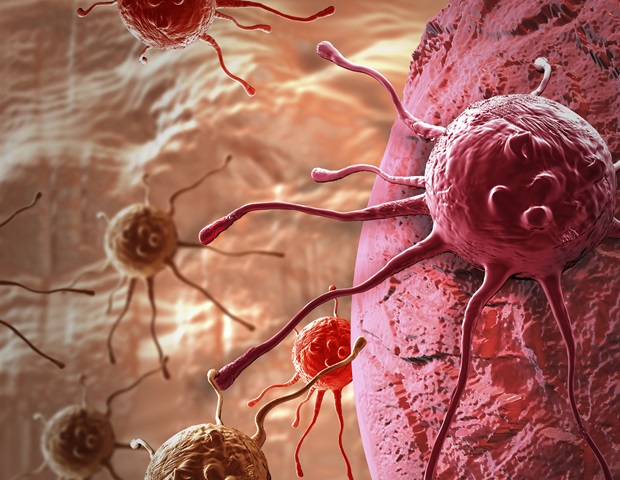
By detecting DNA fragments in body fluids like urine, some types of cancer can already be traced in an early stage. But in order to capture them, detection sensitivity has to be improved.
Researchers of the University of Twente in The Netherlands (MESA+ Institute) use electrically charged polymers for this. Not just one layer of this, but dozens. In this way they manage reaching a 25 times higher sensitivity, as they show in Chemistry of Materials journal.
Some types of cancer leave biomarkers in body fluids. For colorectal cancer and lung cancer, for example, markers are found in urine and feces. Together with, among others, the Amsterdam UMC, the University of Twente works on tests for this.
The biomarkers are DNA fragments that are representative for the specific cancer: each fragment has the characteristic sequence and mutation. Using a surface that is complementary, it is made possible that the fragment 'clicks' on it. A separate probe for each type of cancer is necessary.
Because the amount of fragments in a sample is very small, a very sensitive method is needed that isn't easily fouled by the liquid. Pretreatment and purification of the sample will help. But increasing the number of binding sites on the sensor is adequate as well. This is what the UT researchers did.
They do this using polyelectrolyte multilayers (PEM's) polymers that are electrically charged and enable layer-by-layer construction that is alternately positive and negative. PEM's are known for their robust structure.
If you build them linearly, however, the structure will be very dense and with few binding places. If you build it exponentially, the structure will be more and more open going upward from the first layer.
This openness gives many binding sites. The structure presented in 'Chemistry of Materials' has 33 layers, improving DNA sensitivity by 25 times.
This type of DNA detection improves the use of 'liquid biopsy'. Instead of tissue biopsy, some body fluid is taken.
This is currently getting more attention, as it is simpler, less invasive and cheaper. Liquid biopsy isn't limited to cancer, it is also used for neurodegenerative diseases and cystic fibrosis, for example.
Movilli, J., et al. (2020) Enhancement of Probe Density in DNA Sensing by Tuning the Exponential Growth Regime of Polyelectrolyte Multilayers. Chemistry of Materials. doi.org/10.1021/acs.chemmater.0c02454.
https://news.google.com/__i/rss/rd/articles/CBMifWh0dHBzOi8vd3d3Lm5ld3MtbWVkaWNhbC5uZXQvbmV3cy8yMDIwMTEwNC9JbXByb3Zpbmctc2Vuc2l0aXZpdHktb2YtbGlxdWlkLWJpb3BzeS11c2luZy1sb29zZWx5LXN0YWNrZWQtZGV0ZWN0aW9uLWxheWVycy5hc3B40gGBAWh0dHBzOi8vd3d3Lm5ld3MtbWVkaWNhbC5uZXQvYW1wL25ld3MvMjAyMDExMDQvSW1wcm92aW5nLXNlbnNpdGl2aXR5LW9mLWxpcXVpZC1iaW9wc3ktdXNpbmctbG9vc2VseS1zdGFja2VkLWRldGVjdGlvbi1sYXllcnMuYXNweA?oc=5
2020-11-04 12:13:00Z
CBMifWh0dHBzOi8vd3d3Lm5ld3MtbWVkaWNhbC5uZXQvbmV3cy8yMDIwMTEwNC9JbXByb3Zpbmctc2Vuc2l0aXZpdHktb2YtbGlxdWlkLWJpb3BzeS11c2luZy1sb29zZWx5LXN0YWNrZWQtZGV0ZWN0aW9uLWxheWVycy5hc3B40gGBAWh0dHBzOi8vd3d3Lm5ld3MtbWVkaWNhbC5uZXQvYW1wL25ld3MvMjAyMDExMDQvSW1wcm92aW5nLXNlbnNpdGl2aXR5LW9mLWxpcXVpZC1iaW9wc3ktdXNpbmctbG9vc2VseS1zdGFja2VkLWRldGVjdGlvbi1sYXllcnMuYXNweA
Bagikan Berita Ini














0 Response to "Improving sensitivity of liquid biopsy using 'loosely stacked' detection layers - News-Medical.net"
Post a Comment